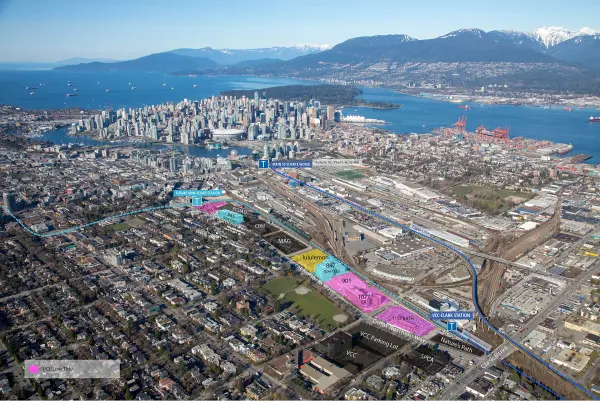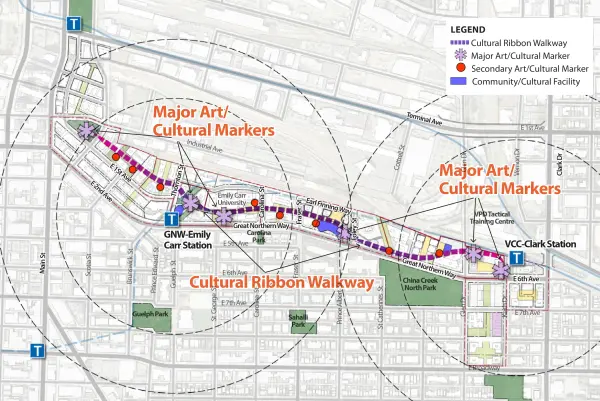Indigenous Advisory Committee

PCI Developments (PCI) and Low Tide Properties wanted to know how they could actively contribute to Truth and Reconciliation through their South Flats projects on Great Northern Way in Vancouver. As development lead and to take action and create change within their companies, PCI co-developed an Indigenous Advisory Committee (IAC) to advise and rethink processes that would integrate Coast Salish and Indigenous knowledge. The IAC is committed to providing feedback on policies and processes, and help to incorporate Indigenous knowledge and practices into their work. The creation of the IAC has already created significant positive impacts on their work and community. While there is still continued work to be done, PCI and the IAC are proud of the progress that has been made and is committed to continuing to learn and evolve how their projects can actively contribute towards advancing the collective knowledge and respect for Coast Salish history and culture.
PCI co-developed an Indigenous advisory committee with Cory Douglas, Ginger Gosnell-Myers, and Aaron Aubin — all accomplished Indigenous professionals and Tim Grant, President of PCI. The committee’s clear objective is to affirm PCI and Low Tide’s commitment to revitalizing xʷməθkʷəy̓əm, Sḵwx̱wú7mesh, and səlilwətaɬ (MST Nations) cultural identity and history in the area traditionally known as Skwachàys. This will be accomplished through the creation of new processes and practices that support the integration of Coast Salish and Indigenous knowledge throughout the South Flats project.

Cory Douglas, a Squamish Nation member with Haida and Tsimshian ancestry, was born and raised in Coast Salish Territory, now Vancouver. He is connected to the Squamish Nation through his parents and has been learning traditional Haida form and formline and Coast Salish Design. He started his business as a graphic artist and continues to redefine himself as he merges his academic architectural vocation with his innate creativity. His intention is to communicate the cultural history of Canada alongside the development and design strategies through decolonization.
Ginger Gosnell-Myers is Nisga’a and Kwakwak’awakw, whose 20+ year career challenging colonial systems is creating new pathways for radical change. She is the first Indigenous Fellow with the Simon Fraser University Morris J. Wosk Centre for Dialogue, where she focuses on Decolonization and Urban Indigenous Policy and Planning. Her work centres on the creation of new planning and design processes so that Indigenous knowledge is reflected meaningfully throughout, ensuring co-learning for all parties in centered, going beyond the normal token or decorative only approaches. Ginger’s goal is to re-define government policies and industry processes, creating new standards that meet commitments to UNDRIP and the TRC 94 Calls to Action.
Aaron Aubin is a Kwakwa̱ka̱ʼwakw person and member of the Da’naxda’xw / Awaetlala First Nation whose traditional territory is in the Knights Inlet, BC. He grew up on Vancouver Island, regularly visits his traditional territory and actively participates in his culture. He is a registered professional planner with over 20 years of experience in architecture, land use planning, strategic planning, governance, and community engagement. He is the President and Founder of Aubin Consulting, which dedicates its work to delivering projects that have societal benefits and empower meaningful dialogues between Indigenous communities and government and corporations.
Tim Grant is the president of PCI Developments LP. He was born and raised in the Coast Salish Territory, now called Vancouver, in a family that has been involved with the building and land development industry for generations. Reflecting on the history of the land and how developments have shaped the realities of Indigenous peoples today, he aims to support Reconciliation by acknowledging and fostering relationships with the MST Nations and Indigenous peoples residing in the Coast Salish territory.
For the past year, PCI has been working alongside the Indigenous Advisory Committee in preparation of its upcoming rezoning application for South Flats which will be comprised of transit-oriented, complete communities at existing VCC-Clark Station and future GNW-Emily Carr Station on Great Northern Way. PCI and its partner Low Tide Properties, have embarked on a new path that will demonstrate how the South Flats projects can advance reconciliation with Indigenous communities through meaningful engagement, respectful relationships, and supporting equitable access to jobs, training, and education opportunities.

In 2021, PCI took on the leadership role of bringing together developers and collaborators for a design charrette aimed at shaping the future development of the South Flats area. Cory Douglas and Ginger Gosnell-Myers, two Indigenous cultural advisors based in Vancouver, guided the concept of Cultural Ribbon at the time, leading the conversation towards a more culturally inclusive approach to the development plans for the South Flats area.
The Cultural Ribbon is then incorporated into policies in the City of Vancouver, such as the Broadway Plan (2022). As outlined, collaborators are asked to establish the Cultural Ribbon that will span the Creative District and form a link from East Vancouver towards False Creek. The Cultural Ribbon shall be a walkway that will showcase Coast Salish knowledge and culture through elements such as art, signage, public realm/landscape design and architecture.

The vision and guiding principle statements are founded on the importance of recognition, learning, accountability, relationship building and Chenchénstway. These statements reflect the commitments made to advancing Truth and Reconciliation and acknowledge that it is an evolving process that will offer tremendous learnings for the South Flats projects.
“South Flats celebrates the identities of the xʷməθkʷəy̓əm, Sḵwx̱wú7mesh, and səlilwətaɬ Nations, weaving together our shared aspirations that advance Reconciliation.”
Recognition — Making visible the culture, history, and identities of xʷməθkʷəy̓əm, Sḵwx̱wú7mesh, and səlilwətaɬ Nations
Learning — Listening with intent while fostering space for co-learning and unlearning
Accountability — Using seven generation thinking to guide accountability
Relationships — Paddling together: strengthening relationships through thoughtful processes
Chenchénstway — Lifting each other up along this journey
South Flats’s guiding principles are based on the spindle whorl, which was used by Coast Salish people for weaving beautiful textiles, often into items with cultural, spiritual and social significance. The whorl is typically carved out of wood or stone with geometric, animal or human designs. Before European contact and the introduction of sheeps wool, wool was gathered from Salish “wool dogs” and sometimes combined with goat wool, goose down, and plant matter in the spinning process.

Incorporating Coast Salish and Indigenous knowledge of the South Flats sites was a foundational necessity, and the IAC hosted workshops with Knowledge Keepers — xʷməθkʷəy̓əm – Elder Shane Point, Sḵwx̱wú7mesh – Chief Ian Campbell, and səlilwətaɬ – Councillor Charlene Aleck. The Design Teams were introduced to the rich yet often unknown Coast Salish histories of the area and provided everyone with important knowledge that will inform the next steps of the design and development process.
The Indigenous Advisory Committee has identified the following groups for engagement and collaboration: Musqueam, Squamish, Tsleil-Waututh Nations, Knowledge Keepers, Indigenous youth, urban Indigenous communities, City of Vancouver Indigenous Relations Office and other key groups. The Indigenous Advisory Committee is inspired for this next phase of engagements, working alongside the Design Team. The South Flats project will host engagements concurrently, focused on external engagement and collaboration with key groups, and internal collaboration for the IAC with the Design Team. PCI and Low Tide understand that the road to Truth and Reconciliation is an evolving one and requires ongoing commitment, engagement and collaboration.
Click below to see what we’ve done so far!

